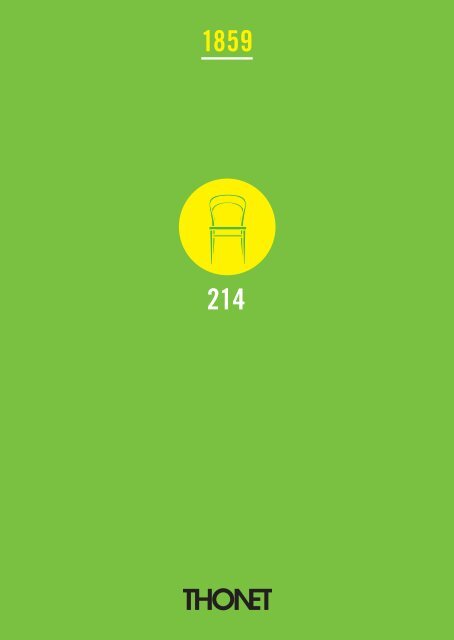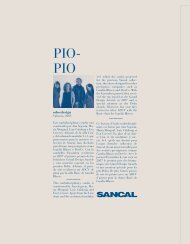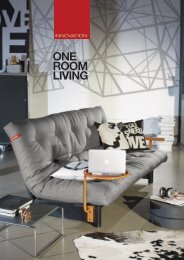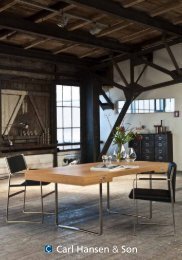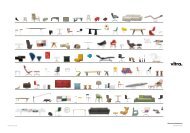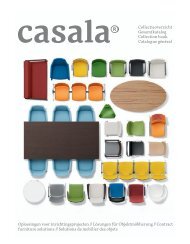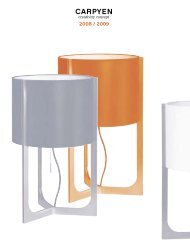Monographie 214 - Thonet GmbH
Monographie 214 - Thonet GmbH
Monographie 214 - Thonet GmbH
Erfolgreiche ePaper selbst erstellen
Machen Sie aus Ihren PDF Publikationen ein blätterbares Flipbook mit unserer einzigartigen Google optimierten e-Paper Software.
1859<br />
<strong>214</strong>
Design Michael <strong>Thonet</strong>
Michael <strong>Thonet</strong><br />
Michael <strong>Thonet</strong> 1796 in Boppard am Rhein geboren, absolvierte eine<br />
Lehre als Bau- und Möbeltischler. 1819 eröffnete er als Meister seine eigene<br />
Werkstatt. Zwischen 1830 und 1836 gelingt ihm die Erfindung der ”Möbel<br />
aus gebogenem Holz”. 1842 holt ihn Fürst Metternich nach Wien. Zunächst<br />
arbeitet er bei verschiedenen Unternehmen und verfeinert weiter seine<br />
Technik des Holzbiegens. 1849 gründet er, zusammen mit seinen 5 Söhnen,<br />
die eigene Möbelwerkstatt, 1853 überschreibt er ihnen das Unternehmen, es<br />
wird protokolliert unter ”Gebrüder <strong>Thonet</strong>”. <strong>Thonet</strong> operiert sehr erfolgreich:<br />
auf Weltausstellungen werden die Möbel ausgezeichnet, u.a. in London 1851<br />
und 1862, es entstehen eigene Verkaufsniederlassungen in den Großstädten<br />
der ganzen Welt – von Amsterdam bis New York, und der Exportmarkt floriert.<br />
Später produzieren rund 6000 Mitarbeiter in 7 Fabriken rund 865.000 Stühle<br />
pro Jahr. 1871 stirbt Michael <strong>Thonet</strong> in Wien. Sein wichtiger Grundsatz war<br />
die Familientradition. Heute führt die 5. <strong>Thonet</strong>-Generation das Unternehmen<br />
in Frankenberg (Deutschland), dem 1889 gegründeten Standort.
Michael <strong>Thonet</strong> born 1796 in Boppard/Rhine River, trained as a<br />
carpenter and joiner. In 1819 he opened his own workshop as a master<br />
craftsman. Between 1830 and 1836, he invented the „furniture made of bent<br />
wood“. In 1842, Prince Metternich brought him to Vienna. At first, he worked<br />
for various companies and refined his technique of bending wood. In 1849,<br />
he founded his own furniture workshop, recorded as „Gebrüder <strong>Thonet</strong>“, together<br />
with his 5 sons; he signed it over to them in 1853. <strong>Thonet</strong> became a<br />
very successful operation: the furniture was awarded at World Fairs, among<br />
others in London in 1851 and 1862; sales offices in large cities throughout the<br />
world were established – from Amsterdam to New York – and the export market<br />
boomed. Later on, around 6,000 employees produced about 865,000 chairs<br />
in 7 factories each year. Michael <strong>Thonet</strong> died in 1871 in Vienna. His important<br />
principle was family tradition. Today, the 5th generation is managing the company<br />
in Frankenberg (Germany), the location founded in 1889.<br />
Michael <strong>Thonet</strong> and sons
Das Prinzip <strong>Thonet</strong>. Die geniale Erfindung, Möbel aus gebogenem<br />
Massivholz herzustellen, markiert den Beginn der Geschichte des Modernen<br />
Möbels schlechthin. Diese Technik ermöglichte erstmals die Serienfertigung.<br />
Dabei werden Holzelemente durch Dampf-Einwirkung biegsam gemacht und<br />
dann in eine Metallform gebogen. Zum Trocknen bleiben sie mehrere Tage in<br />
dieser Form, danach ist das Bugholz formstabil.<br />
The <strong>Thonet</strong> principle. The ingenious invention of producing furniture<br />
made of solid bent wood marks the beginning of modern furniture<br />
history. This technique for the first time enabled serial production. Wood<br />
elements are made flexible through the influence of steam and then bent in<br />
a metal mould. They remain in this mould for several days to dry; afterwards,<br />
the bentwood is dimensionally stable.
<strong>Thonet</strong> – Pionier der Design-<br />
Geschichte. Die einzelnen Elemente eines<br />
Modells lassen sich im Baukastenprinzip mit Teilen<br />
anderer Modelle kombinieren - damit schaffte<br />
<strong>Thonet</strong> bereits Mitte des 19. Jahrhunderts die<br />
Grundlage für die Typen- und Modellvielfalt der<br />
späteren Industrieproduktion. Für Transport und<br />
Lagerung gab es ein vorbildliches Konzept: in eine<br />
Kiste mit einem Kubikmeter Volumen passten 36<br />
zerlegte Stühle, die erst an Ort und Stelle montiert<br />
wurden. In diesen Kisten wurden die Produkte in die<br />
ganze Welt exportiert, nach Nord- und Südamerika,<br />
Afrika und Asien.<br />
<strong>Thonet</strong> – a pioneer of design history. The individual elements<br />
of a model could be combined with parts from other models following<br />
the modular design principle – in the mid-19th century, <strong>Thonet</strong> had thus<br />
already established the basis for the variety of models of the later industrial<br />
production. An exemplary concept was developed for transportation and storage:<br />
36 disassembled chairs could be packed into a box with a volume of<br />
just one cubic meter – they were assembled only on site. The products were<br />
exported throughout the world in these boxes, to North and South America,<br />
Africa and Asia.
Ein Stuhl erobert die Welt. Mit über 50 Millionen Exemplaren<br />
allein bis 1930 ist der <strong>214</strong>, mit der früheren Modellnummer 14, nicht nur der<br />
meist gebaute Stuhl der Welt und Inbegriff des modernen Massenkonsumartikels,<br />
sondern er gilt auch als das gelungenste Industrieprodukt des<br />
19. Jahrhunderts.<br />
A chair conquers the world. With more than 50 million pieces<br />
sold until 1930 alone, the chair no. <strong>214</strong>, formerly model no. 14, is not only the<br />
most frequently produced chair in the world and the epitome of the modern<br />
mass consumer product, but it is also considered the most successful industrial<br />
product of the 19th century.
Casino Bar Eslava, Pamplona (ES), architects Kahle Oiza Aranzo
Die Klassiker aus Bugholz werden von <strong>Thonet</strong> noch immer im<br />
traditionellen Verfahren und in bewährter Qualität produziert. Das Original<br />
erkennen Sie am eingebrannten <strong>Thonet</strong>-Signet mit der Jahreszahl auf der<br />
Unterseite des Sitzrahmens.<br />
”Noch nie ist Eleganteres<br />
und Besseres in der Konzeption,<br />
Exakteres in der<br />
Ausführung und Gebrauchstüchtigeres<br />
geschaffen<br />
worden” (Le Corbusier)<br />
<strong>214</strong> 215<br />
43 cm<br />
84 cm<br />
52 cm<br />
46 cm<br />
The bentwood classics are still produced by <strong>Thonet</strong> today with<br />
the traditional processing and well-proven quality. You can recognize the<br />
original by the embossed <strong>Thonet</strong> logo with the year on the bottom of the seat<br />
frame.<br />
„Never before was something<br />
more elegant and better in<br />
its conception, more precise<br />
in its realization and more<br />
fit for practical use created“.<br />
(Le Corbusier)<br />
43 cm<br />
84 cm<br />
52 cm<br />
46 cm
Classics for Kids. Kindermöbel haben bei <strong>Thonet</strong> eine lange<br />
Geschichte. Bereits die Lagerliste von 1873 enthielt kleine Stühle und Tische,<br />
im Katalog von 1884 ergänzt mit Betten und Wiegen aus Bugholz. Aus dieser<br />
Tradition heraus fertigen wir heute wieder klassische Entwürfe für den<br />
Nachwuchs.<br />
Classics for Kids. Children’s furniture has a long tradition at<br />
<strong>Thonet</strong>. The stock list from 1866 already included small chairs and tables,<br />
complemented in the 1879 catalog with bentwood beds and cradles.<br />
Today, we again produce classic designs for children in the spirit of this<br />
tradition.
Ein Stuhl geht in die Geschichte ein. Bugholzstühle und<br />
-möbel findet man in Sammlungen und Ausstellungen von Museen und<br />
Galerien weltweit, z.B. im Museum of Art in New York, im Centre Pompidou in<br />
Paris, im Design Museum und Victoria and Albert Museum in London, im<br />
Vitra Design Museum und in der Pinakothek der Moderne in München. Außerdem<br />
sind zahlreiche Bücher und Kataloge darüber erschienen.<br />
A chair enters into history. Bentwood chairs and furniture can<br />
be found in collections and exhibitions of museums and galleries throughout<br />
the world, for example in the Museum of Modern Art in New York, the Centre<br />
Pompidou in Paris, the Design Museum and Victoria and Albert Museum in<br />
London, the Vitra Design Museum and the Pinakothek der Moderne in Munich.<br />
In addition, numerous books and catalogues have been published.<br />
Pinakothek der Moderne, Munich (D)
Der Werkstoff Holz spielt bei <strong>Thonet</strong> eine wichtige Rolle, gebogen<br />
oder verformt, in Schichtholz oder massiv. Dabei ist die handwerkliche<br />
Fertigung ein entscheidender Schritt im gesamten Produktionsprozess.<br />
Wood as a working material plays an important role for <strong>Thonet</strong><br />
– whether bent or shaped, glued or solid. The craftsmanship is a decisive<br />
aspect of the entire production process.<br />
14 K <strong>214</strong> <strong>214</strong> K <strong>214</strong> P <strong>214</strong> F<br />
215 R<br />
A 660 F<br />
215 PF<br />
A 661<br />
209<br />
404<br />
210 R 233<br />
404 F
THONET <strong>GmbH</strong><br />
Michael-<strong>Thonet</strong>-Straße 1<br />
D-35066 Frankenberg<br />
Telefon +49 - 64 51 - 508 - 119<br />
Telefax +49 - 64 51 - 508 - 128<br />
info@thonet.eu<br />
www.thonet.eu<br />
06.2010.15


